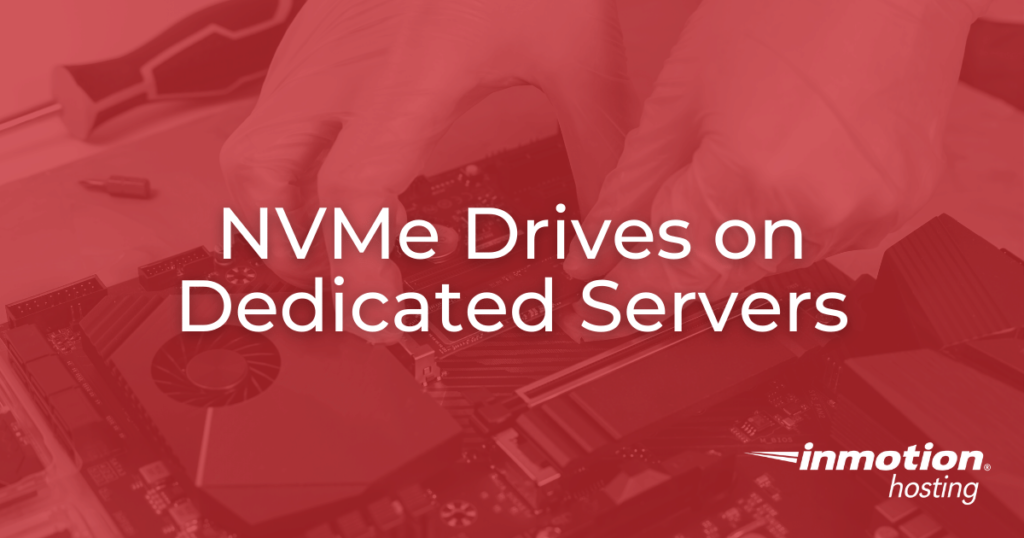
NVMe drives, short for Non-Volatile Memory Express drives, are one of the newest technologies to be widely adopted in modern web hosting environments. These high-tech hard drives provide faster transfer rates than their predecessors, making NVMe drives a crucial component of high-performance web server hardware. In this article we will discuss why NVMe drives on dedicated servers provide a unique advantage over other data storage solutions.
Topics Include:
The Benefits of NVMe Technology
NVMe, as mentioned previously, stands for Non-Volatile Memory Express. Non-volatile memory exists for the purposes of long-term data storage, and most modern flash drives and hard drives use non-volatile memory for flash data storage. NVMe differs from standard non-volatile memory, having been designed to take full advantage of high-speed PCI-based storage solutions to perform parallelized storage tasks.
Rather than storing data sequentially, NVMe drives can store data in parallel, speeding up data transfer rates and by extension boosting server performance. Think of it like roadway traffic. If there is only one lane on a busy street, traffic will move more slowly than if there were multiple lanes allowing cars to move in parallel. NVMe technology is like a multi-lane highway whereas SATA technology is more like a single-lane road.
NVMe Form Factors
While M.2 is the newest form factor for NVMe storage solutions, there are a number of other form factors of NVMe that can be installed on most servers. Some form factors use standard PCI Express (PCIe) expansion slots while others use dedicated NVMe slots.
Add-In Cards
One of the earliest forms of NVMe storage was the add-in card (AIC). These drives are much larger than the M.2 in terms of physical size and require the use of a PCIe 2.0 or 3.0 interface. Two sizes of add-in cards exist: Half Height, Half Length (HHHL) and Full Height, Half Length (FHHL).
U.2 and U.3
The U.2 form factor provided an interface for the connection of solid-state drives using PCI Express ports. It was improved upon for U.3, a connection interface that combines SATA, SAS, and NVMe support. U.3 also allowed for hot-swapping between different drives depending on firmware availability.
M.2
The M.2 form factor provides an interface for the installation of solid-state drives via the M.2 connector. As an upgrade to the U.2 form factor, M.2 provides interfaces for PCI Express 3.0 or PCI Express 4.0.
Benefits of NVMe Drives on Dedicated Servers
Now that we’ve reviewed the various forms of NVMe memory we can discuss the potential benefits of using NVMe drives on dedicated servers, particularly the M.2 form factor.
Faster Data Transfer Rates
When an M.2 NVMe drive is installed on a server, it interfaces via a designated PCIe slot rather than a standard SATA cable. This method of interfacing allows the installed NVMe drive to transfer data to and from the rest of the computer more quickly than it could with a SATA connection. By combining high-speed PCI Express interfaces with parallelized data storage processing, NVMe drives are able to provide the fastest data transfer rates out of any storage medium to date.
Through the use of M.2 NVMe technology on your dedicated server, you can drastically speed up site load times and enhance overall server performance.
Smaller Physical Space Requirement
Since M.2 NVMe drives are relatively small when compared to standard 2.5 inch solid-state hard drives, they take up less physical space within the server itself. This can help reduce the clutter of a cramped server box and give you additional storage space without using too much of your server’s real estate. In a situation where space is at a premium, the M.2 form factor is the obvious choice.
No SATA Cables
By interfacing directly with the motherboard via the M.2 connector, M.2 NVMe drives avoid needing to use bulky SATA cables. These cables can add additional clutter to a crowded rack-mounted server, so getting rid of them in favor of an M.2 drive may be an ideal solution if you find your server overheating. Alternatively, the M.2 connector can be used to install an additional storage device even if all of the available SATA slots are in use by other hard drives.
The performance boost offered by NVMe drives combined with the space-saving M.2 form factor makes it an excellent choice for any dedicated server owner, regardless of your level of expertise.
Scale your business with high-performance dedicated hosting. Choose from Managed Dedicated Servers powered by cPanel, or select a Bare Metal Server for complete server control via the command line.
DDoS Protection
99.99% Uptime
Software RAID
New Customer Discounts